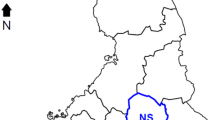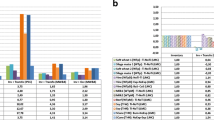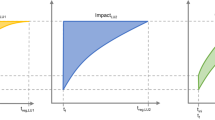Abstract
Purpose
Regional values for prospective soil organic carbon (SOC) change in Australian cropland were derived via state-of-the-art modelling. This paper evaluates the applicability of the results in the context of life cycle assessment (LCA).
Methods
Results of soil carbon modelling need to align with LCA requirements in order to be applicable. The following aspects were investigated in more detail: effect of SOC and variability on product carbon footprint results, data symmetry and consistency, attribution of the SOC change to activity and allocation of the SOC change to crops in rotations.
Results and discussion
Results show that greenhouse gas (GHG) emissions or removals associated with SOC change even in the absence of recent land use change or land management change can potentially change Australian crop carbon footprints considerably. Over a modelling period of 62 years, the SOC continues to change. In attributional LCA, issues with attribution, allocation and data symmetry of the SOC change values are complex. Without a comprehensive understanding of the causal link between individual crops and pasture in a rotation and the change in SOC, and without a SOC change figure for an appropriate reference baseline, application in attributional LCA is limited to certain types of studies only. In consequential LCA, the data symmetry issues as well as the need for allocation and attribution can be avoided.
Conclusions
The SOC change results cannot be allocated to individual crops and are therefore valid only for a full rotation cycle. This means results may be applied in attributional LCA but only in certain contexts. The main applicability is foreseen as a business-as-usual baseline for consequential LCA. A set of SOC change values will be derived for this purpose and made available with accompanying guidance for use and interpretation.






Similar content being viewed by others

Notes
The terms attributional and consequential LCA are used as implied in Soimakallio et al. (2015) and references therein. This means the terms go beyond the average versus marginal definition, and are more in line with the accounting versus change-oriented definition of the ILCD Handbook (European Commission 2010)
References
ABS (2013) Australian Bureau of Statistics 7124.0 – historical selected agricultural commodities by state (1861 to present), 2011. www.abs.gov.au Released Wed 06 March 2013
ABS (2015) Australian Bureau of Statistics 7121.0 - agricultural commodities, Australia, 2013–14. www.abs.gov.au. Accessed 23 June 2015
ABS (2019) Australian Bureau of Statistics 7121.0 - agricultural commodities, Australia, 2016–17. www.abs.gov.au. Accessed 07 Jan 2019
Batalla I, Knudsen MT, Mogensen L, Hierro ÓD, Pinto M, Hermansen JE (2015) Carbon footprint of milk from sheep farming systems in northern Spain including soil carbon sequestration in grasslands. J Clean Prod 104:121–129
Bessou C, Benoist A, Tailleur A, Godard C, Gac A, Lebas de la Cour J, Boissy J, Mischler P (2018) Accounting for land use contribution to climate change in agricultural LCA: which methods? Which impacts? Proceedings of the LCA Food 2018 conference, Bangkok
Bhatia P, Cummis C, Draucker L et al (2011) Greenhouse gas protocol product life cycle accounting and reporting standard. World Resources Institute and World Business Council for Sustainable Development, September 2011
Brander M (2015) Response to “attributional life cycle assessment: is a land-use baseline necessary?”—appreciation, renouncement, and further discussion. Int J Life Cycle Assess 20(12):1607–1611
BSI (2011) PAS 2050:2011 specification for the assessment of the life cycle greenhouse gas emissions of goods and services. BSI London, Sep 2011
Cao V, Margni M, Favis BD, Deschênes L (2016) Choice of land reference situation in life cycle impact assessment. Int J Life Cycle Assess 22(8):1220–1231
Durlinger B, Koukouna E, Broekema R, van Paassen M, Scholten J (2017) Agri-footprint 4.0, part 1: methodology and basic principles. 14 December 2017, Gouda
European Commission, Joint Research Centre, Institute for Environment and Sustainability (2010) International reference life cycle data system (ILCD) handbook - general guide for life cycle assessment - detailed guidance. EUR 24708 EN. Luxembourg. Publications Office of the European Union; March 2010
Goglio P, Smith WN, Grant BB, Desjardins RL, McConkey BG, Campbell CA, Nemecek T (2015) Accounting for soil carbon changes in agricultural life cycle assessment (LCA): a review. J Clean Prod 104:23–39
Grant T, Eady S, Cruypenninck H, Sharma B, Simmons A (2019) AusLCI methodology for developing life cycle inventory for Australian agriculture, due for release mid 2019. Lifecycles, Melbourne
Hoffmann M, Jurisch N, Garcia Alba J, Albiac Borraz E, Schmidt M, Huth V, Rogasik H, Rieckh H, Verch G, Sommer M, Augustin J (2017) Detecting small-scale spatial heterogeneity and temporal dynamics of soil organic carbon (SOC) stocks: a comparison between automatic chamber-derived C budgets and repeated soil inventories. Biogeosciences 14:1003–1019
ISO (2006) International standard ISO 14044:2006(E) environmental management – life cycle assessment – requirements and guidelines. Geneva, July 2006
ISO (2018) International standard ISO 14067:2018(E) greenhouse gases — carbon footprint of products — requirements and guidelines for quantification. Geneva, Aug 2018
Knudsen MT, Dorca-Preda T, Djomo SN, Peña N, Padel S, Smith LG, Zollitsch W, Hörtenhuber S, Hermansen JE (2019) The importance of including soil carbon changes, ecotoxicity and biodiversity impacts in environmental life cycle assessments of organic and conventional milk in Western Europe. J Clean Prod 215:433–443
Luo Z, Wang E, Sun OJ (2010) Soil carbon change and its responses to agricultural practices in Australian agro-ecosystems: a review and synthesis. Geoderma 155(3–4):211–223
Luo Z, Wang W, Sun OJ, Smith CJ, Probert ME (2011) Modeling long-term soil carbon dynamics and sequestration potential in semi-arid agro-ecosystems. Agric For Meteorol 151(12):1529–1544
Luo Z, Eady S, Sharma B, Grant T, Liu DL, Cowie A, Farquharson R, Simmons A, Crawford D, Searle R, Moore A (2019) Mapping future soil carbon change and its uncertainty in croplands using simple surrogates of a complex farming system model. Geoderma 337:311–321
Milà i, Canals L, Bauer C, Depestele J, Dubreuil A, Freiermuth Knuchel R, Gaillard G, Michelsen O, Müller-Wenk O, Rydgren B (2006) Key elements in a framework for land use impact assessment within LCA. J Life Cycle Assess 12(1):5–15
Muller S, Lesage P, Ciroth A, Mutel C, Weidema BP, Samson R (2014) The application of the pedigree approach to the distributions foreseen in ecoinvent v3. Int J Life Cycle Assess 21(9):1327–1337
Nemecek T, Schnetzer J, Reinhard J (2014) Updated and harmonised greenhouse gas emissions for crop inventories. Int J Life Cycle Assess 21(9):1361–1378
Parajuli R, Knudsen MT, Djomo SN, Corona A, Birkved M, Dalgaard T (2017) Environmental life cycle assessment of producing willow, alfalfa and straw from spring barley as feedstocks for bioenergy or biorefinery systems. Sci Total Environ 586:226–240
Probert ME, Delve RJ, Kimani SK, Dimes JP (2005) Modelling nitrogen mineralization from manures: representing quality aspects by varying C:N ratio of sub-pools. Soil Biol Biochem 37(2):279–287
Pulkkinen H, Katri Joensuu K, Hietala S (2018) Including soil carbon and land use changes to comparison of carbon footprints of beef production systems. Proceedings of the LCA Food 2018 conference, Bangkok
Salvador S, Corazzin M, Romanzin A, Bovolenta S (2017) Greenhouse gas balance of mountain dairy farms as affected by grassland carbon sequestration. J Environ Manag 196:644–650
Soimakallio S, Cowie A, Brandão M, Finnveden G, Ekvall T, Erlandsson M, Koponen K, Karlsson P-E (2015) Attributional life cycle assessment: is a land-use baseline necessary? Int J Life Cycle Assess 20(10):1364–1375
Stanley PL, Rowntree JE, Beede DK, DeLonge MS, Hamm MW (2018) Impacts of soil carbon sequestration on life cycle greenhouse gas emissions in Midwestern USA beef finishing systems. Agric Syst 162:249–258
Svanes E, Woodhouse A (2018) Sustainability of plant protein vs protein of animal origin. Proceedings of the LCA Food 2018 conference, Bangkok
Tabatabaie SMH, Tahami H, Murthy GS (2018) A regional life cycle assessment and economic analysis of camelina biodiesel production in the Pacific Northwestern US. J Clean Prod 172:2389–2400
Vagnoni E, Franca A, Arca P, Sanna L, Duce P (2018) The effect of carbon sequestration on the environmental implications of a Pecorino Romano PDO sheep supply chain. Proceedings of the LCA Food 2018 conference, Bangkok
Van Vuuren DP, Edmonds J, Kainuma M et al (2011) The representative concentration pathways: an overview. Clim Chang 109:5–31
Wernet G, Bauer C, Steubing B, Reinhard J, Moreno-Ruiz E, Weidema B (2016) The ecoinvent database version 3 (part I): overview and methodology. Int J Life Cycle Assess 21(9):1218–1230
Williams J, Hook R, Hamblin A (2002) Agro-ecological regions of Australia; methodologies for their derivation and key issues in resource management. CSIRO Land and Water
Author information
Authors and Affiliations
Corresponding author
Additional information
Responsible editor: Hayo M.G. van der Werf
Publisher’s note
Springer Nature remains neutral with regard to jurisdictional claims in published maps and institutional affiliations.
Rights and permissions
About this article
Cite this article
Sevenster, M., Luo, Z., Eady, S. et al. Including long-term soil organic carbon changes in life cycle assessment of agricultural products. Int J Life Cycle Assess 25, 1231–1241 (2020). https://doi.org/10.1007/s11367-019-01660-4
Received:
Accepted:
Published:
Issue Date:
DOI: https://doi.org/10.1007/s11367-019-01660-4



